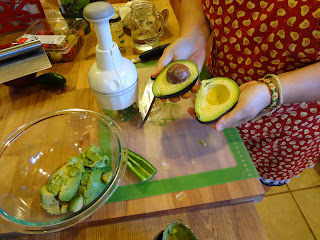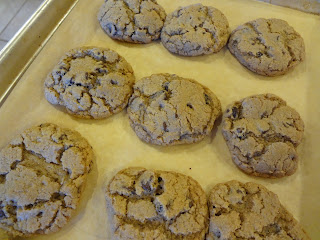I'm a fairly simple gal. I don't wear makeup at home, only shave my legs when we're expecting more than 3 days of sunshine, and consider lavender goat's milk soap to be the equivalent of a large bottle of Dior perfume.
Honestly, anything with the word "fume" in it is lost on me.
I also enjoy finding multiple ways to use something up before tossing it into the recyclable bin, Goodwill box, compost pile, or pig trough.
With all of the cheesemaking I've been doing lately, I'm finding that the whey tends to add up. Especially if I make a 2 lb. batch of cheese on a daily basis.
Ya. We like cheese.
After doing a quick Google search on ricotta, I found a recipe using just the whey. Whey is the liquid that is left after
all the milk solids are used to form the curds. At least, I
thought they were all used up.
Looking into the pot, I couldn't see how anything else could be extracted from the liquid. Sure, there were little white particles floating on top, but they were few and far between, and according to the recipe, for every 2 gallons of whey used, I should expect 2-3 cups of ricotta.
Well, if you know me at all, I like a good challenge. Even if my ricotta adventure ended up being an epic fail, I would have the satisfaction of knowing that
I doubted this little endeavor to begin with. And for a simple gal like me, that can be
good enough.
Occasionally though, I like to be proven wrong. ☺
Here's what you'll need:
2 gallons leftover whey from
making mozzarella
a large pot that has several inches of space at the top once the whey is added
long-handled slotted spoon (I use a skimmer.)
2 thin 100% (non-terry) cotton towels, or several layers of cheesecloth
colander
thermometer
Set a colander in a large pot and line the colander with 1 towel. Strain your fresh whey through the towel to remove any bits and pieces that may be in the liquid. Remove colander/towel and place a lid on the pot. Set the pot on the back of the stove and leave it for 12-24 hours to culture.
The next day, remove the lid and place the pot on medium heat. Bring the temperature up to 208 degrees, stirring occasionally to keep the solids from sticking to the bottom of the pot. (Trust me, those solids are in there, even if you can't see them!)
Be careful when taking the temperature, the steam is very hot! See how the yellow-ish liquid has turned white and foamy? This is what you want.
Give the whey another good stir, remove from heat and replace the lid. And wait. For me, this is the toughest part.
I'm simple, not patient.
When the liquid is cool enough to handle, line your colander with towel #2 and set inside another large pot. Gently scoop out the solids. I scoop as much as possible, then gently pour the rest through the towel/colander.
Once most of the liquid has drained from the solids, gather the corners of your towel and tie with a rubberband. Hang the cheese to drain until the bag no longer drips, approximately 1 hour. Don't worry if your ricotta drains longer; if it's too dry, you can add a little milk or cream until it reaches a consistency that you like.
 |
| I use a muslin bag for hanging the ricotta. |
Don't worry about getting fancy with the hanging, just make sure that there's a pot beneath to catch the drips. Trust me.
 |
| My fancy method of hanging cheese works great, unless I need cinnamon out of the spice cabinet.☺ |
One the cheese is drained, scrape it out of the towel and place in a covered glass bowl. Refrigerate for up to 1 week.
Use your ricotta in pasta dishes, as a base for dips or salad dressings, or on pancakes with a little homemade jam. Yum!
And if you have have chickens or pigs, they'll appreciate the
leftover-
leftover whey.
 |
| Our newest pigs~The Haminator, Porkticus, and Swineheart |
Probably more than the homecoming "gifts" of free bagels and doughnuts.
I think the "boys" and I are going to get along just fine, don't you?






















































